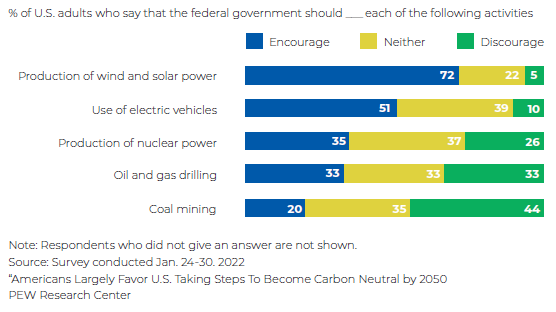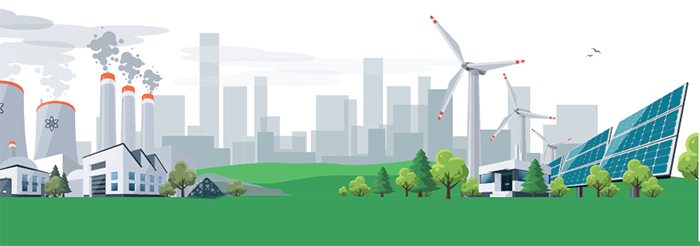Consumers want to buy from greener sources – how can retailers react?By Eric Alam
Start now
What drives consumer buying decisions at retail? Packaging? Shopping environment? Brand recognition? Customer Service?
Of course.
But increasingly, a new hurdle has been raised by much of the buying community – what does this brand, this store believe? Are they part of the problem or are they working to be part of the solution?
Consumers have never had so many buying options. Isn’t it logical that when confronted with multiple choices, new buying criteria/justifications will rise in importance as consumers seek to find a comfort level with the buying decisions they make?
Anyone with a news feed knows it’s ultimately consumers who are driving a transformation of the energy grid from its traditional fossil fuel-based approach to a brave renewable world.
Majority of U.S. adults say federal government should encourage production of wind and solar power

Politicians, regulators, corporate influencers of global brands, investors and, of course, the media are leading the charge to a renewable energy-based future. Why? Because they are all in the same business: Predicting, shaping and responding to consumer attitudes
and actions.
The argument of how much of this growing consumer preference for brands that embrace a sustainability-based philosophy is being driven by outside factors and influencers, can be had in another space. The cause is less important to the bottom line of retailers than the reality of what has arrived on their doorsteps and home pages.
What to do about it?
All of us in any form of sales are faced with the perpetual dilemma… the customer’s perception is my reality.
No one wants to argue that a cleaner environment, healthier planet, fair work practices and a sensitivity to underserved communities is bad thing.
The important questions for the retail community are:
- How do I capitalize on this trend?
- How do I respond when my biggest consumer products’ brands are telling me that I need to contribute to their sustainability objectives if I want to continue to be part of their supply/distribution chain?
If this sounds cynical, it is not meant to be. Rather it’s a recognition that consumer buying decisions are the life blood of retailers, and differentiation is the only path to creating brand awareness in an unprecedentedly chaotic environment of consumer choices.
Step 1. Acceptance and action planning
- Establish sustainability as a core value for your organization – consumers, suppliers and employees are looking for reasons to believe
- Define the low hanging fruit in your operations that will garner demonstrable sustainability wins and credibility
- Define criteria for these actions that will allow you to share your wins with your stakeholders
Step 2. Your sustainability journey starts with actions that you can implement now
- One of the most visible, easiest and immediate impacts can be switching to renewable energy to power your operations
- Assess other aspects of your business and stakeholder demands to address packaging and brand promotion of other sustainable-oriented suppliers and products
- Evaluate your employee diversity score and seek opportunities promote a healthy culture and work environment
A good sustainability first-step: 100% renewable energy from a local source
Revamping business processes and changing culture are complex and long-term undertakings. Making the decision to switch to renewable energy is not.
Russian aggression in Ukraine and the upheaval it has caused in energy markets worldwide has had an interesting effect on energy decisions:
The traditional green premium is a minor aspect of overall energy cost. In other words, the impact of finding the right renewable energy product for your operations is cheaper now than it has ever been.
The energy market is complex, but the right solutions can be simple, impactful and affordable. No action a retailer can take will be more visible than promoting a store/website/supply chain is powered by 100 percent renewable energy from a local wind, solar or hydro generator. You do not need to build your own wind farm, commit to a 15- year contract for more volume than you can consume or settle for questionably impactful green offsets. Nor do you have to overhaul your rooftop or parking lot.
Solutions exist in the market that will allow you to promote the answers to the following key questions that will resonate with your consumers, employees and suppliers:
- Where is my green power sourced?
- What makes it green?
- What impact did my purchase make?
To find out more, talk to your energy provider or consultant, or find a company that focuses on your needs and objectives.
Transformation at a macro level is a long journey. But the first steps can be easy, and the impact they make on culture, values and consumer perception can be profound. Given the power and velocity behind the sustainability movement and the differentiation opportunity it creates to capture the hearts, minds and actions of customers, employees and investors cannot and should not be ignored.
Sustainability is about much more than renewable energy. It is a commitment to what’s become increasingly more important to your buyers. It starts with an action plan that asks how do I change? How do I start? How do I communicate that we are committed to this path? The first steps create a foundation from which to build. The first decisions set the stage for demonstrating a commitment that will fuel the long-term goal of helping build a more just, more equitable, more buyable brand.
Eric Alam
Eric Alam is CEO at RPD Energy. RPD Energy facilitates the sourcing, contracting and delivery of green energy solutions for US businesses. Fortune 500 energy buyers have chosen RPD Energy to work with their suppliers to provide green energy contracts for their data centers, production facilities and corporate headquarters in several regions across the US.
